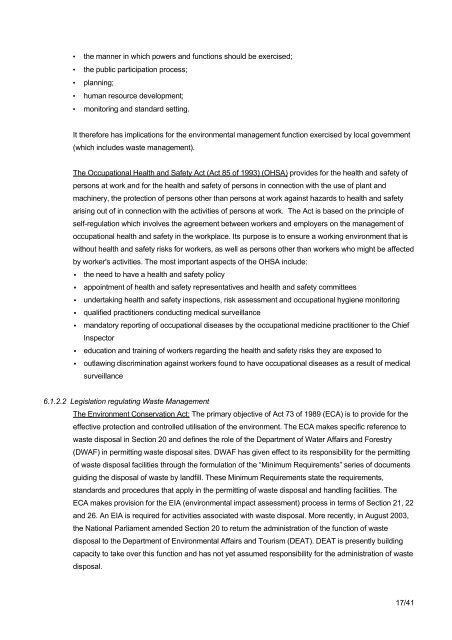E-WASTE ASSESSMENT IN SOUTH AFRICA - e-Waste. This guide
E-WASTE ASSESSMENT IN SOUTH AFRICA - e-Waste. This guide
E-WASTE ASSESSMENT IN SOUTH AFRICA - e-Waste. This guide
Create successful ePaper yourself
Turn your PDF publications into a flip-book with our unique Google optimized e-Paper software.
• the manner in which powers and functions should be exercised;• the public participation process;• planning;• human resource development;• monitoring and standard setting.It therefore has implications for the environmental management function exercised by local government(which includes waste management).The Occupational Health and Safety Act (Act 85 of 1993) (OHSA) provides for the health and safety ofpersons at work and for the health and safety of persons in connection with the use of plant andmachinery, the protection of persons other than persons at work against hazards to health and safetyarising out of in connection with the activities of persons at work. The Act is based on the principle ofself-regulation which involves the agreement between workers and employers on the management ofoccupational health and safety in the workplace. Its purpose is to ensure a working environment that iswithout health and safety risks for workers, as well as persons other than workers who might be affectedby worker's activities. The most important aspects of the OHSA include:▪ the need to have a health and safety policy▪ appointment of health and safety representatives and health and safety committees▪ undertaking health and safety inspections, risk assessment and occupational hygiene monitoring▪ qualified practitioners conducting medical surveillance▪ mandatory reporting of occupational diseases by the occupational medicine practitioner to the ChiefInspector▪ education and training of workers regarding the health and safety risks they are exposed to▪ outlawing discrimination against workers found to have occupational diseases as a result of medicalsurveillance6.1.2.2 Legislation regulating <strong>Waste</strong> ManagementThe Environment Conservation Act: The primary objective of Act 73 of 1989 (ECA) is to provide for theeffective protection and controlled utilisation of the environment. The ECA makes specific reference towaste disposal in Section 20 and defines the role of the Department of Water Affairs and Forestry(DWAF) in permitting waste disposal sites. DWAF has given effect to its responsibility for the permittingof waste disposal facilities through the formulation of the “Minimum Requirements” series of documentsguiding the disposal of waste by landfill. These Minimum Requirements state the requirements,standards and procedures that apply in the permitting of waste disposal and handling facilities. TheECA makes provision for the EIA (environmental impact assessment) process in terms of Section 21, 22and 26. An EIA is required for activities associated with waste disposal. More recently, in August 2003,the National Parliament amended Section 20 to return the administration of the function of wastedisposal to the Department of Environmental Affairs and Tourism (DEAT). DEAT is presently buildingcapacity to take over this function and has not yet assumed responsibility for the administration of wastedisposal.17/41
















